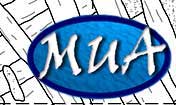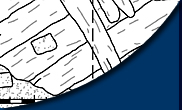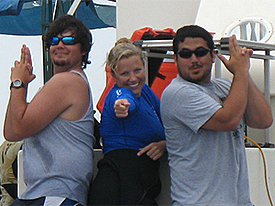
Wes Perrine, Sara Linden, and Andy Marr are Archaeology’s Angels.
This past weekend some of us took a trip to Vortex Springs in Ponce de Leon, Florida. The dive trip was a relaxing experience to explore the mouth of the spring in crystal clear waters that we never get to see in Pensacola Bay. After the refreshing dive we headed back to begin another week of archaeological excavations in the bay. On Monday we returned to the barge and the teams dredged in their respective units. Wes Perrine and Andy Marr spent their morning mapping last week’s previously found outer hull planking and frames.
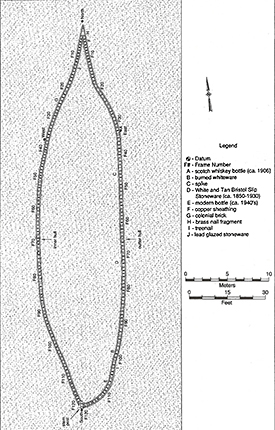
Our current site plan of the B-Street Schooner. (Large View)
Tuesday marked the beginning day of investigations on the B-Street Schooner. The B-Street lies in about 7 feet of water near the shore in Pensacola Bay. Before any excavations can be done, a baseline must be carefully laid on the wreck, so that precise measurements can be taken and objects properly mapped in. Dive teams 3 and 5 were chosen to lay out the baseline and tape measure on the wreck. The wreck is orientated with what is believed to be the stern to the north and the bow to the south. The sandy bottom around the B-Street was much looser than we were used to, and the rebar that we used to secure the ends of the line was too short and came out of the sand easily, so that it will require another day to set the baseline once longer pieces have been obtained. Teams continued to explore the wreck despite this minor setback. Hand fanning of the sediment revealed a very large central timber and the outline of the outer hull. The wreck itself is teeming with marine life including sheepshead fish, crabs, rockfish, and even a stingray that was spotted. Back on EPII teams continued to dredge and recover artifacts. The South unit uncovered a frame with a round shape and ceramics nearby.
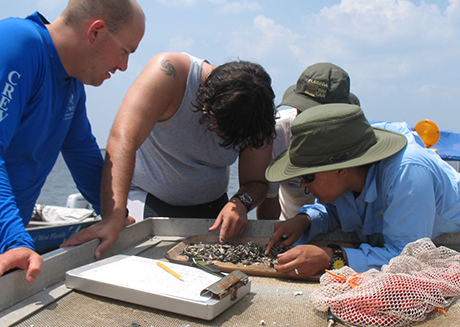
Scott Sorset, Wes Perrine, John Smith and Irina Franklin sorting through dredge spoil.
Every week, some of the teams are split up so that we can experience different aspects of maritime archaeology, including various forms of survey, target diving, excavations at the B-Street Schooner site, as well as working in the lab. Two days a week, various students go to the conservation lab to learn what happens to the artifacts once they are excavated. Students in the lab assigned artifact numbers to artifacts that were sorted from dredge spoil. They recorded artifacts by their type, weight, size, condition and began the conservation process by placing the artifacts in fresh water. Artifacts are also measured and drawn to scale, with photographs to follow. Field school students learned this week that one of the bones recovered from the amidships unit was in fact the right radius of a fetal pig, and that some of the artifacts thought to be bone were in fact cooked.
The survey exercise for the week consisted of learning how to use the magnetometer. John Smith and Marisa Foster were the lucky two chosen this week to learn how to properly set up the survey equipment, and how to systematically use the equipment so as to get thorough coverage of the bay floor. As the supervisors took turns running the boat in straight lines guided by the GPS, a sometimes difficult task made even harder by rough water or strong winds, we towed the magnetometer behind looking for any ferrous objects on the bay floor. After running about 10 lines of 300 meters in length, we disassembled the survey equipment and headed back to the office to examine our data. Back in the lab, we were able to sort through the data we acquired, and determine if any of the hits were found were worthy of closer examination.
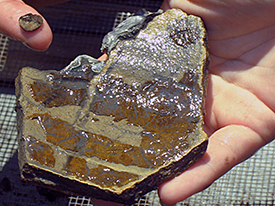
Olive Jar Fragment with Pez, a pine pitch sealing resin.
Accidents happen, and it seems that not a week goes by that something doesn’t fall off the side of the barge. No worries though, it just gives us more practice conducting circle searches and improving our skills of locating objects underwater. On Wednesday, team 4 performed circle searches around the barge to try and locate a pair of lost prescription glasses. The team successfully located the glasses along with other gear and tools previously lost to the bay. The teams in the stern unit finished level 2 (20-40 cmbs) and began the excavation of level 3 (40-60 cmbs). More ship frames and timbers are being uncovered as we excavate. The amidships unit continued to remove ballast, finding various olive jar pieces and animal bones in the process.
Thursday, some of the teams were to return to the B-Street Schooner and place a more secure baseline, and triangulate the locations of the units to be excavated. However, the bay was too rough for the boat we use at the B-Street, so those teams couldn’t go out. Instead of just calling it a day, though, we visited a local sail making company, Schurr Sails, that Helen Welch works at. We were able to see how modern sails are produced, using some of the tools that have gone unchanged for hundreds of years. Watching the process of making sails gave us a new appreciation for the lives of the sailors in the Age of Sail, especially considering the technology and materials they had to work with.
Friday began with replacing one the last of our barge’s old anchor lines, so that hopefully we wouldn’t have any more surprises with broken anchor lines. Since Friday was our half day for diving, we had two teams focus on dredging, with a third focus solely on moving the previously excavated ballast in order to keep the areas around the units clear. We also are finding more indications that the ships were re-ballasted prior to the voyage from Mexico to Pensacola, as were are finding Caribbean-specific coral deeper and deeper within and amongst the ballast of the ship.
Please feel free to contact us if you have any questions or concerns at: mua@keimaps.com.
Return to Project Journal home page.
